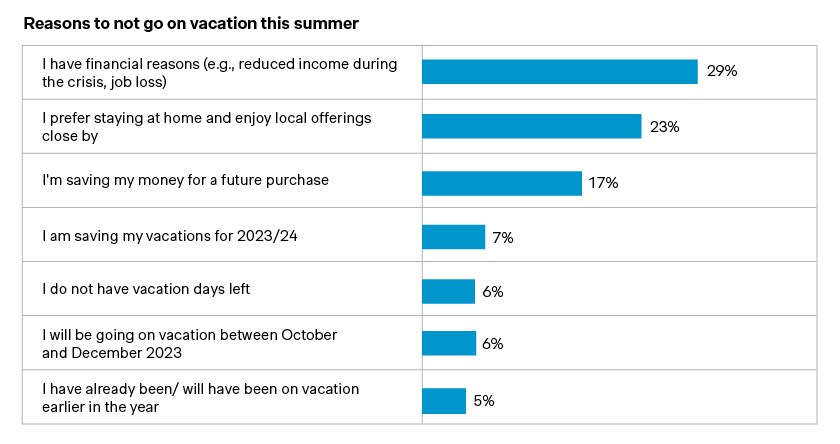In today’s fast-paced world, travel has become an essential part of our lives. However, with ongoing cost-of-living pressure, consumers and corporate travelers are facing tough choices and being pushed to alter their travel behavior. The US findings to our Global Travel Study revealed evolving trends that may up-end some travel industry norms and open doors to new solutions.
As financial constraints weigh heavily on consumers’ minds, approximately 30% of travelers are opting out of vacations, and prioritizing essential expenses. This shift in consumer priorities has far-reaching implications for the travel industry, leading to changes in booking habits, strained business travel, and having many considering alternative modes of transportation as an option.
Christmas in July?
The cost-of-living crisis is reshaping consumer travel behavior, compelling travelers to reassess their vacation plans; and dreams of a get-away is being deferred as they focus on necessities such as housing, healthcare, and education. The respondents in our study confirm a tightening of the purse strings - 29% stated they would not be going on vacation this summer due of financial reasons and 23% will be simply taking advantage of enjoying local activities.

On a brighter side, the revival of advance booking has emerged as a popular trend. Approximately 52% of travelers are opting to book their vacations well in advance, a strategy that allows them to lock in lower prices and secure their trips amidst uncertainties in the economy. The “early birds” segment comprises over one-third of these forward planners, driven by the fear of being priced out of a vacation. By booking early, they aim to shield themselves from potential price hikes in accommodations, transportation, and other travel-related expenses.
From planes to trains: corporate travelers are cutting back on dollars and distance
No one can argue that the economic climate has significantly impacted business travel. Rising costs have led to strained budgets, prompting approximately 15% of consumer professionals to forego business travel altogether. Those who continue to travel for work are adapting their plans by opting for shorter trips to cut down on expenses.
Now, we understand that travel by train isn’t as prominent in the US as it is in other countries, but for those that are opting for shorter trips, trains are trending. Our study revealed 46% of US consumers’ employers updated their travel policy to encourage travel by train and two-thirds are actively encouraging their employees to travel by train rather than plane. Though this may raise eyebrows as a pain point for travelers not wanting to add time to their trips, 47% are willing to travel more than 8 hours.
Simply put, trains offer a more economical alternative for short to medium distances, if it’s an option. As an added bonus, this shift aligns with the growing emphasis on sustainability and eco-conscious travel practices. Which is one area travelers being willing to spend more money - an average of 33% of respondents are willing to spend more for an environmentally sustainable vacation.
3 Strategies for Stability and Growth in the Travel Industry
By devising a well-defined strategy, the travel industry can better navigate headwinds, capitalize on opportunities, and chart a course towards a resilient and profitable future. We have developed a strategic blueprint for industry leadership to implement for short, mid, and long-term success. Below, we have given a snapshot of some tactics industry leaders can implement now for quick wins and long-term success.
Value-Based Pricing, Dynamic Pricing, and Surgical Price Increases:
Businesses can strike a balance between maximizing revenue and maintaining customer satisfaction by consistently monitoring market trends, customer preferences, and competitor pricing.
- Pursue value-based pricing to match price levels to value; extract segmented willingness-to-pay with logic-based, differentiated pricing strategies based on relevant value drivers. This will work as a foundation in building a value-based price architecture that can help identify underserved price points of opportunity.
- Dynamic pricing strategies that integrate seasonality, demand, and customer behavior foster growth and stability.
- Utilizing data analytics and consumer research, companies can identify pricing opportunities and apply surgical price increases for specific products or services while avoiding negative volume effects by aligning prices to psychological thresholds (e.g., unit pricing at $99 instead of $80 to capture added dollars without exceeding the $100 psychological threshold).
- Bolstering value to the offering can help justify price increases at a fraction of the cost: this can be done by offering value-added services, personalized experiences, or exclusive benefits to justify the increased prices.
Effective Sales Strategies:
Optimizing Direct-to-Consumer (DTC) Sales
DTC sales allow businesses to build strong relationships with customers, gather valuable data, and offer a more personalized experience.
- Refresh your value communication based on perceived importance and performance across value drivers, and tailor messaging in the DTC storefront to target customers on a segment level.
- Incorporate behavioral nudging in the customer’s journey online to encourage upsell of value-added ancillary offerings (e.g., travel packages, car rentals, hotels, etc.) like a clear upsell path, social validation, and curated offerings.
Growing eCommerce Partnerships and Enhancing SEO
Leveraging eCommerce partnerships can extend the reach of products and services to a larger audience.
- Strategically partner with online travel agencies, tour operators, or hotel booking platforms to enhance and expand online storefront presence and communicate value proposition to each platform’s most relevant customer segments.
- Investing in search engine optimization (SEO) by using link building tools, and improving the product hierarchy on a website by conducting a Google Analytics audit can boost online visibility and drive organic traffic.
Customer-Centric Marketing Strategies:
Prioritize strategies that drive customer lifetime value
- Offer personalized incentives, loyalty programs, and exclusive offers to encourage repeat business.
- Be an industry leader and use predictive analytics to anticipate and identify the “next best offer” for individual current, lapsed, and prospective customers based on their preferences and past purchases.
Retention and Win-Back Tactics:
Implement targeted marketing campaigns to retain existing customers and win back those who have churned.
- Offering special discounts, loyalty rewards, or personalized offers (like personalized bundled travel packages) to current and lapsed customer segments to drive loyalty and re-engagement with the brand, respectively.
Solutions to drive long-term growth for travel industry businesses
Macroeconomic headwinds have reshaped the travel and tourism industry, prompting consumers to prioritize essential expenses over vacations, and businesses to rethink travel policies. While challenges persist, there is hope on the horizon, as travelers find novel ways to explore the world while mindful of their financial constraints. As we move forward, adaptability and consumer-centric awareness when developing business strategies will remain key to thriving in the ever-evolving landscape.
Where some solutions to offset the macroeconomic headwinds in the travel industry may appear straightforward, without a strategic plan that identifies the unique challenges and opportunities within the sector, achieving sustained recovery and growth may prove elusive.
Short-term fixes like implementing promotional campaigns and discounted offers can provide short-term relief, however a comprehensive strategy is necessary to address the complex issues that can develop into margin erosion in turbulent economic times. A well-crafted strategy that draws on multiple factors such as changing consumer behaviors, evolving technologies, and emerging travel trends will deliver the long-term solutions required for growth.








